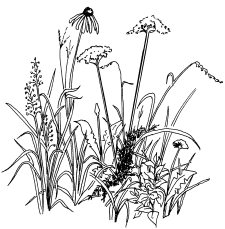
Indicator Species
Regal Fritillary: Speyeria idalia
Missouri status: Vulnurable
IUCN status has not been determined.
Natural history:
Primary population threat is loss of habitat. Genetically Modified Organisms such as BT corn and soybeans as well as the long duration of Neoniconitoid (Neonic) insecticides also play a role in their decline. Larvae (caterpillars) feed on members of genus Viola (Violets). Usually bird’s-foot violet and prairie violet here in Missouri. There is a significant symbiotic connection with both host and nectar plants in larval and adult stages. Adults feed on the nectar of a variety of prairie plants and in doing so, fulfill a pollinator role for those plants. Examples: Milkweed, Thistle, Coneflower, Liatris, Sunflowers, Goldenrods, & Ironweed. Thistle and Milkweed provide large nectar contributors for this species due to the staggered blooming times for these two large groups of plants. This species (caterpillar and adult) is preyed upon by other insects, birds, and small mammals.
Habitat:
Dependent on grassland ecosystems. Range is estimated to have been reduced by at least 30%.
Range:
Isolated to remnants of tall grass prairies from Montana to Maine. Range map difficult to calculate.
http://www.abirdshome.com/resource/usa/80.htm
http://www.butterfliesandmoths.org/species/Speyeria-idalia
Links:
http://mdc.mo.gov/discover-nature/field-guide/regal-fritillary
http://www.xerces.org/regal-fritillary/
http://www.butterfliesandmoths.org/species/Speyeria-idalia
http://www.nature.org/newsfeatures/specialfeatures/animals/insects/regal-fritillary-butterfly.xml
https://en.wikipedia.org/wiki/Regal_fritillary
Guiding questions for predicting the future of this species at Tucker Prairie:
-
Does this species account lend evidence to support the ability to adapt to changing vegetation, soil moisture, and climate?
-
Are the habitat requirements for this species broad or specific?
-
What is your prediction for the success of this species at Tucker Prairie if climate change results in a gradual conversion of Tucker Prairie from native prairie to shrubs and eventually woodland?
-
What does this species eat? What other species eats the Fritillary?
-
Consider your answers to the previous three questions. Given the complex symbiotic relationship between host/pollinator plants and this species of butterfly, what are some implications for the overall prairie ecosystem with a changing climate at Tucker prairie?
-
Why should we care about changes in the population of a butterfly like the Regal Fritillary? Socially is this important or not? Why?





